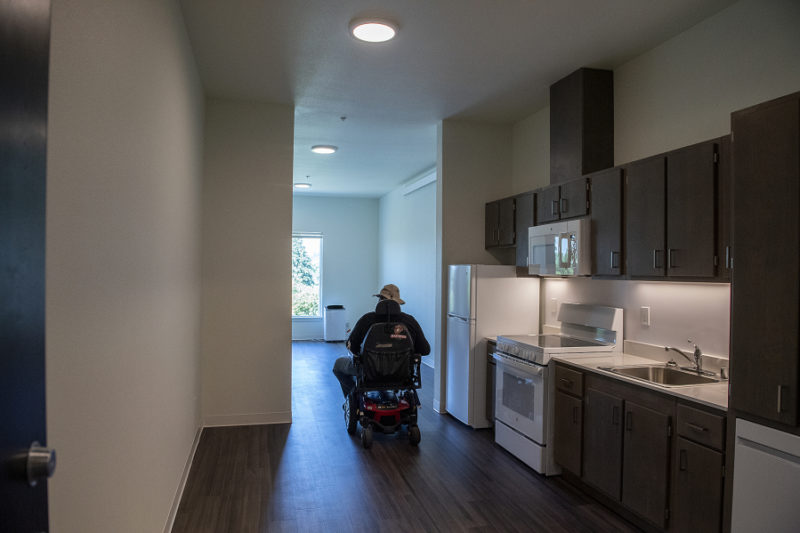Lack of firm definitions creates confusion, VHA’s CEO says
The terms low-income housing and affordable housing are often used interchangeably, causing confusion for many.
So, what is the distinction? The answer is complicated.
As defined by the U.S. Department of Housing and Urban Development, affordable housing is any housing that costs an owner or renter no more than 30 percent of gross household income, including utilities.
Low-income, on the other hand, describes households earning at or below 80 percent of an area’s median income.
The area median income is calculated by HUD annually for different communities and is adjusted based on household size. It is used to determine the eligibility of applicants for federally and locally funded housing programs.
Some sources claim that while affordable housing is simply housing that is affordable based on an area’s median income, low-income housing encompasses several federally funded housing programs.
BASIC HOUSING DEFINITIONS
AFFORDABLE HOUSING: As defined by the U.S. Department of Housing and Urban Development, this is any housing that costs an owner or renter no more than 30 percent of gross household income, including utilities.
AREA MEDIAN INCOME: Calculated by HUD annually for different communities. By definition, 50 percent of households within the specified geographic area earn less than the AMI, and 50 percent earn more. AMI is adjusted based on household size and used to determine the eligibility of applicants for federally and locally funded housing programs. Clark County’s area median income in 2021 was $75,253, according to the Vancouver Housing Authority.
LOW-INCOME: Describes households earning at or below 80 percent the area median income ($60,202 in Clark County).
VERY LOW-INCOME: Describes households earning at or below 50 percent of the area median income ($37,626 in Clark County).
EXTREMELY LOW-INCOME: Describes households earning at or below 30 percent of the area median income ($22,575 in Clark County).
HOUSING CHOICE VOUCHER (SECTION 8): The federal government’s major program for assisting very low-income families, the elderly and people with disabilities to afford housing in the private market. Eligible households may not have income exceeding 50 percent of AMI. Participants are free to choose any housing that meets the requirements of the program.
LOW INCOME HOUSING TAX CREDIT: The Washington State Housing Finance Commission allocates these credits to for-profit and nonprofit developers to build or rehabilitate low-income housing. Large corporations and financial institutions invest in the housing to gain tax credits and reduce their income tax obligations. Projects funded through this source must serve residents below 60 percent of the area median income and accept Section 8 vouchers.
MULTI-FAMILY HOUSING TAX EXEMPTION: The city of Vancouver’s program allows for an eight- or 12-year tax exemption on the value of newly constructed or rehabbed residential units located in the Vancouver city center or Fourth Plain Corridor area. Developers utilizing the 12-year option must make 20 percent of the project’s units affordable to households earning up to 115 percent of the area’s median income.
PUBLIC HOUSING: A specific category of rental housing for low-income households that is owned and managed by a local public housing agency.
SUBSIDIZED HOUSING: Housing in which a publicly financed incentive is provided in the form of a direct payment, fee waiver or tax relief to the housing developer, property owner or individual renter to create affordable units. Subsidized housing may be publicly or privately owned.
WORKFORCE HOUSING: Housing that is affordable to households earning between 50 percent and 80 percent of the area median income ($37,626 to $60,202 in Clark County). These households do not qualify for rental assistance subsidies, but their incomes are too low for market-rate rents to be affordable.
But those definitions vary, and housing that is often described as low-income may not be related to federally funded housing programs, according to Andy Silver, chief operating officer with the Vancouver Housing Authority.
“What leads to this confusion is that there is no universal definition for either of those terms,” he said. “I think one of the reasons people have started using the term low-income housing more is because the term affordable housing is used in so many different ways.”
The Vancouver Housing Authority is attempting to move away from the terms low-income housing and affordable housing in favor of more specific terms, such as subsidized housing and workforce housing.
“We use the term subsidized housing when we refer to people being able to pay based off a percentage of their income, versus affordable housing or other terms where it might just be a flat rent that’s regulated below market,” Silver said.
Subsidized housing is housing in which a publicly financed incentive is provided in the form of a direct payment, fee waiver or tax relief to the housing developer, property owner or individual renter to create affordable units, according to HUD. Subsidized housing may be publicly or privately owned.
Workforce housing is housing that is affordable to households earning between 50 percent and 80 percent of an area’s median income, according to HUD. These households do not qualify for rental assistance subsidies, but their incomes are too low for market-rate rents to be affordable.
Examples
One example of subsidized housing in Vancouver is Miles Terrace, a recently developed apartment complex for low-income seniors where rent subsidies are available.
Examples of affordable, nonsubsidized housing include Esther Short Commons in downtown Vancouver and K West Apartments in central Vancouver, which are both income restricted. Esther Short Commons is owned by the Vancouver Housing Authority, while K West Apartments is owned by a for-profit company.
Those apartments could be described as affordable or low-income housing, but describing them as subsidized and nonsubsidized is more specific, Silver said.
“I personally don’t use the term low-income housing very often, and I think that’s because it sort of takes a characteristic about a household that is not set in stone and changes over time and uses that to characterize them and the place that they live,” he said.
The lack of firm definitions when it comes to affordable housing can cause confusion and even distrust, according to Silver.
“Because there’s no agreed-upon definition, the community is often skeptical when something’s described as affordable housing, of whether it’s really affordable,” he said. “Some people look at the cost to build new multifamily housing, which is quite high these days with the cost of materials and labor, and they say, ‘How can we call this affordable housing? Look how much it costs to build.’ And again, it’s sort of just people talking past each other a bit because they’re using terms differently.”
Other terms
Additional terms get thrown into the mix, as well, causing even more confusion, such as public housing, housing choice vouchers and the multifamily housing tax exemption.
“I think most people outside of our line of work hear public housing and probably think that just means more affordable housing, like a general term,” Silver said.
Public housing is in fact a specific category of rental housing for low-income households that is owned and managed by a local public housing agency.
“It’s a specific federal program that means a very specific thing,” Silver said.
The Housing Choice Voucher Program is the federal government’s major program for assisting very low-income families, seniors and people with disabilities to afford housing in the private market. Eligible households may not have income exceeding 50 percent of an area’s median income, and participants may choose any housing that meets the requirements of the program.
The city of Vancouver’s Multi-Family Tax Exemption program allows for an eight- or 12-year tax exemption on the value of newly constructed or rehabbed residential units located in the Vancouver city center or Fourth Plain Corridor area. Developers utilizing the 12-year option must make 20 percent of the project’s units affordable to households earning up to 115 percent of the area median income, according to the city of Vancouver.
“Wherever somebody’s coming from, whether they want more affordable housing or less affordable housing or cheaper affordable housing, I think the fact that there aren’t common definitions and there are these multiple terms, it just leads to more and more confusion,” Silver said.
Ultimately, keeping up to date with terminology surrounding affordable housing will help people better understand both Vancouver’s affordable housing crisis and its potential solutions, Silver said.
“I wish I could just say, ‘This is the definition of low-income housing, and this is the definition of affordable housing,’ but unfortunately, that’s not the world that we live in,” he said. “It’s more about just having the overall plan of: What are the incomes people make in our community? What are the corresponding costs of housing that are going to meet all those needs? And how do we build housing at each of those different income levels?”
Source: columbian.com












